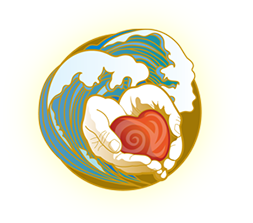As a therapist, I find that it is not unusual for people to hold a grudge against their pain. By the time people come to see me for Biodynamic Craniosacral Therapy or Somatic Experiencing they are tired of their pain. Whether it is physical or emotional, heavy is heavy and pain is pain. Anything carried unresolved for a long time weighs a person down. When we don’t know what we’re carrying it’s harder. And when we feel like we don’t know where our struggle came from and we can’t remember not having it, we don’t think anything can change.
Clients often come because they want to make the pain go away. It always surprises me how many clients use the same phrases: “I just want to feel better… I’ve tried everything… I’m so tired… I just want this feeling to go away!” Wanting to be done with our struggle is an understandable symptom of the struggle, an expression of exhaustion and despair.
It has become a standard line for me to say in response that I hear they are in pain, but I don’t have a magic wand. We both smile, but I am serious. And I go on to say that if I had one, I would not use it. At that point they stop smiling. They have only been in my office minutes, and already it appears I’ve shot their dream out of the sky.
I am all about magic and dreams, but the answer is not to have someone else magically fix our struggles – real empowerment comes from our own agency, from the access to our own capacity and knowing. The reality is change takes time, and all parts of us need to get at least partially onboard. I am not willing to wave a wand or accept the job of trying to make all the pain go away, because it is there for very valid reasons. I won’t support discarding the struggle or summarily dismiss the pain that has been a constant companion.

I explain to clients that I want to help them feel different, but I don’t want to toss out and leave curbside all they have been through. I want to help them meet their discomfort differently, with curiosity. I tell them for that is when I have seen pain transform. We often think we must change something, forgive someone, let go to make the pain go away. In my experience, the more successful route to change is to say hello to what we are trying to “get rid of” and listen to what it has to say.
One morning last week I wrote about the horrific hours of my mother’s death. Her death was a significant trauma for me and shaped the trajectory of my life. I’ve spent countless hours in therapy coming to terms with her absence and have written so much about it too. But there was an ugly and real closeness to the event that my words touched last week, a place I’d been moving steadily towards for a long time.
Then that afternoon, I had the honor of being present with a client, as she felt into the hours of her mother’s death, met her grief and pain, and was able to see and understand the story differently as a result. This was not planned, but it happened, as it has before, when a client’s body recognizes the territory my body has been visiting.
As therapists, our capacity and knowing come from our own life stories. We learn skills in our training, but the majority of us sign up in the first place because of the traumas and triumphs of our lives. If we are good at what we do, our ability to be with our own pain is part of what makes us good. Having met and negotiated our darkest hours makes us unafraid of the dark in another. Having been through something gives us what we need to be present with a client when they are traveling through similar territory.
The veracity of the adage that we can only travel as far as a support person for someone’s journey as we are capable of going ourselves, has borne itself out countless times over my decades of practice. Every person’s body is so intelligent that it will wait as long as it takes for the right circumstances for transformation to occur. Every body will sort inside its own experience for what a particular therapist or bodyworker knows and is capable of both recognizing and being present with.

Sitting in another’s pain with my own. The felt sense of dropping into a deep well and knowing where the bottom is. The sense of strength that I feel. The warmth in my belly and the clammy cave-like sense of cold on the surface of my skin. These are the signs of recognition that I am in place inside myself from where I can confidently harvest the gifts of disaster decades on. What I feel when I know I have arrived at the bedrock of my capacity, at the rock bottom of my own hurt. From here I can be a compass for another. I can help them map where they are because I am sitting in two places: the place where I have been and right here with them where they are.
When I can gift a client with my unfortunate first-hand knowing, I often feel worthy and alive. From there, the struggles and losses of my life gain stature and value, because they give me tools that can lessen the struggle for another. In those moments, the pain is (almost) worth it.
I see pain as a force that all of us carry. Pain is a ready reminder of the grit and grime we have lived through and the fact that we are still here. Sometimes pain is the main way that people become or stay aware of their bodies. Sometimes pain is the ticket to community and connection; other times, the screaming caused by someone’s story being dismissed or ignored.
Pain is the keeper of the story: the knower of what went down. Pain knows every intimate detail of how and when the hurt occurred. Pain has a natural strength. It can stay with a story when other parts of our body or mind are hell bent on getting away. Pain is a survivor.

The things that break us and shatter us into pieces, have the potential to make us whole. They can certainly make us more empathic, caring and capable. They teach us lessons we never wanted to learn and give us tools we would rather not have. They can take us down roads we would otherwise never travel and careen us over cliffs we may never return from.
During sessions, I often speak directly to a client’s physical or emotional pain. I tell the pain what day it is, making sure to include the year. This simple differentiation of now from then is consistently effective if the origin of their pain or struggle happened some time ago. When oriented to the present moment, pain will pause and consider whether its stance is outdated. Even though pain’s been cold shouldered more times than one can count, it often warms to the touch of the moment.
Once the body recognizes that time has passed, and that a particular moment of danger is not happening right now, overwhelm always lessens. When this happens the pain that is caused by the need not to forget softens. It is not simple or easy for this shift to occur, but it is possible with support and connection. It is possible when a skilled therapist can meet a client in the place they are most steadfastly afraid of. When I sit with clients in the place that has numbed their soul and dampened their dreams I think, feel and sometimes say out loud all or part of the following:
May I be here with you? I know this place. I have lived here too. But now I live in a new place where it is sunny and friendly more of the time. I still have hard times, but they are different now. I know you can get to a new place too, and if you want, I’ll take the journey from here towards there with you.
I can’t tell you how long it will take or what will be different when you get there. But I do know it is possible for things to be different, for your pain to be felt in bite size pieces that can be digested. I will know this even when you don’t. I will help you close the floodgates when they crack open. I will re-member softness and connection and joy and the time before this injury on those days when you can’t. I will remember this when your tears flow and your agony runs through every vein, word, movement.
I won’t hold hope, just like I won’t dismiss hurt. I’ll know you in your wholeness and tend the soil there, help you plant the seeds, water the stories and root deeper than now into now – from here to there, hand to hand, pain to possibility.

